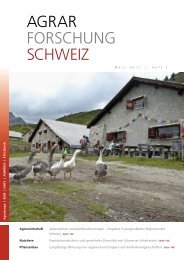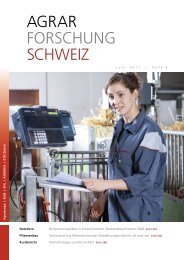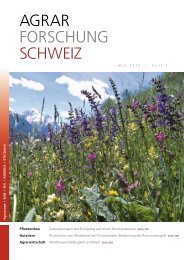Télécharger le PDF - Agrarforschung Schweiz
Télécharger le PDF - Agrarforschung Schweiz
Télécharger le PDF - Agrarforschung Schweiz
You also want an ePaper? Increase the reach of your titles
YUMPU automatically turns print PDFs into web optimized ePapers that Google loves.
Riassunto<br />
Conservazione dei pascoli alberati del Giura:<br />
sfide climatiche e agro-politiche<br />
I caratteristici pascoli alberati del Giura<br />
servono principalmente da foraggio per<br />
animali e forniscono <strong>le</strong>gname. Inoltre, essi<br />
sono anche importanti per la loro biodiversità,<br />
svolgono altre funzioni come aree di<br />
svago e di ricreazione per il tempo libero,<br />
come pure per la qualità del paesaggio che<br />
essi offrono in prossimità del<strong>le</strong> grandi zone<br />
urbane nell’arco <strong>le</strong>manico. Questo articolo<br />
mostra, con l’aiuto di modelli di simulazione,<br />
l’effetto di cambiamenti climatici sulla<br />
produzione di biomassa erbacea e, in questo<br />
contesto, <strong>le</strong> conseguenze della nuova<br />
riforma agraria (PA 14–17) sull’evoluzione<br />
del paesaggio. I pascoli alberati potrebbero<br />
meglio resistere all’aumento del<strong>le</strong> temperature<br />
e alla diminuzione del<strong>le</strong> precipitazioni<br />
estive, rispetto ai pascoli non alberati,<br />
mantenendo una produzione foraggera più<br />
stabi<strong>le</strong>. L’associazione del modello di<br />
vegetazione ad un modello socio-economico<br />
indica che attraverso la nuova politica<br />
agricola (AP 14–17), la pressione di pascolo<br />
diminuirà e che nell’ambito di uno scenario<br />
di moderato riscaldamento climatico questo<br />
porterà a un inforestamento con un<br />
aumento di zone boschive chiuse. La nuova<br />
politica agricola dovrebbe permettere di<br />
prendere del<strong>le</strong> misure mirate per conservare<br />
i pascoli alberati.<br />
Bibliographie<br />
b Barbezat V. & Boquet J.-F. (Eds.), 2008. Gestion intégrée des paysages<br />
sylvo-pastoraux de l'Arc jurassien – Manuel (Handbook). Conférence<br />
TransJurassienne. La Chaux-de-Fonds, Besançon. 160 p. et 1 CD-ROM<br />
(Programme Interreg IIIA).<br />
b Barth L., Lanz S. & Hofer C., 2011. Promotion de la production anima<strong>le</strong><br />
basée sur <strong>le</strong>s herbages dans la politique agrico<strong>le</strong> 2014 – 2017. Recherche<br />
Agronomique Suisse 2 (1), 20–25.<br />
b CH2011, 2011. Swiss Climate Change Scenarios CH2011. Published by<br />
C2SM, MeteoSwiss, ETH, NCCR Climate, and OcCC, Zurich, Switzerland.<br />
b Chételat J., Kalbermatten T., Lannas K., Spiegelberger T., Wettstein J.-B.,<br />
Gil<strong>le</strong>t F., Peringer A. & Butt<strong>le</strong>r A., 2012. A contextual analysis of observed<br />
land-use and vegetation changes applied to two wooded pastures in the<br />
Swiss Jura Mountains. Ecology and Society (en révision).<br />
b Gavazov K., Peringer A., Butt<strong>le</strong>r A., Gil<strong>le</strong>t F. & Spiegelberger T., 2012.<br />
Dynamics of forage production in pasture-woodlands of the Swiss Jura<br />
Mountains under projected climate change scenarios. Ecology and Society<br />
(en révision).<br />
b Gil<strong>le</strong>t F., 2008. Modelling vegetation dynamics in heterogeneous pasture-woodland<br />
landscapes. Ecological Modelling 217 (1–2), 1–18.<br />
Conservation des pâturages boisés du Jura: défis climatiques et agro-politiques | Projet MOUNTLAND<br />
Summary<br />
Conservation of pasture woodlands in the Jura<br />
mountains: climate change and agro-political<br />
chal<strong>le</strong>nges<br />
Wooded pastures of the Jura mountains are<br />
mainly used for fodder and timber production,<br />
but they provide also other goods and services<br />
such as biodiversity, <strong>le</strong>isure areas as well as<br />
attractive landscapes. These ecosystems are<br />
sensitive to climate and land-use changes. In<br />
this paper we report on a transplantation<br />
experiment and model simulations to show<br />
the impact of climate change on the grass<br />
production as well as the consequences of the<br />
upcoming new agriculture policy (AP 14–17) on<br />
landscape dynamics. Results indicate that<br />
wooded pastures could better resist to climate<br />
warming and concomitant summer droughts<br />
than open pastures, and thus provide more<br />
stab<strong>le</strong> fodder yields along the season. Simulations<br />
of vegetation evolution indicate that the<br />
global utilization rate of fodder in tree<strong>le</strong>ss<br />
intensive used pastures would be beyond a<br />
sustainab<strong>le</strong> threshold. The AP 14–17 will lower<br />
the intensity of pasturing which will <strong>le</strong>ad to<br />
more closed landscapes in the long run. The<br />
new policy should allow, by means of incentives<br />
in favour of landscape quality, to take<br />
targeted measures for the conservation of<br />
wooded pastures.<br />
Key words: pasture-woodland, climate<br />
warming, vegetation dynamics, transplantation<br />
experiment, agricultural policy.<br />
b Huber R., Briner S., Peringer A., Widmer A., Gil<strong>le</strong>t F., Seidl R., Lauber S.,<br />
Butt<strong>le</strong>r A., Le Q. B. & Hirschi C., 2012a. Modeling feedback effects between<br />
vegetation dynamics farm structural change and policy development<br />
in the pasture woodlands of the Swiss Jura mountains. Ecology and<br />
Society (en révision).<br />
b Huber R., Iten A. & Briner S., 2012b. Développement du système des<br />
paiements directs et utilisation des terres en montagne. Recherche<br />
Agronomique Suisse 3 (7–8), 354 – 359.<br />
b IPCC, 2007. Climate Change 2007: Synthesis Report. Contribution of<br />
Working Groups I, II and III to the Fourth Assessment Report of the Intergovernmental<br />
Panel on Climate Change, Geneva, Switzerland.<br />
b Mariotte P., 2012. Effects of subordinate plant species on plant and soil<br />
community structure and ecosystem function. Thèse n° 5359 EPFL.<br />
b Miévil<strong>le</strong>-Ott V. & Barbezat V., 2005. Perception du pâturage boisé: résultats<br />
d'un sondage effectué au Communal de la Sagne NE. <strong>Schweiz</strong>. Z.<br />
Forstwes. 156, 1–12.<br />
b Peringer A., Siehoff S., Chételat J., Spiegelberger T., Butt<strong>le</strong>r A. & Gil<strong>le</strong>t F.,<br />
2012. Past and future landscape dynamics in wooded pastures of the Jura<br />
under land use and climate change. Ecology and Society (en révision).<br />
Recherche Agronomique Suisse 3 (7–8): 346–353, 2012<br />
353
















